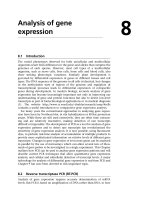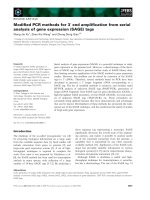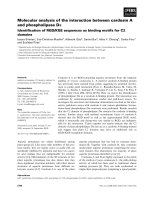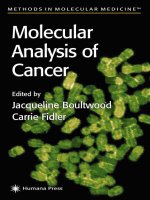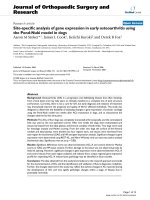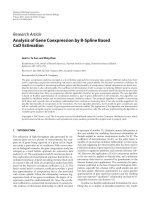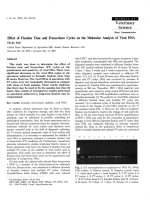Molecular analysis of hibiscus chlorotic ringspot virus coat protein mediated suppression of gene silencing
Bạn đang xem bản rút gọn của tài liệu. Xem và tải ngay bản đầy đủ của tài liệu tại đây (4.02 MB, 187 trang )
MOLECULAR ANALYSIS OF HIBISCUS CHLOROTIC
RINGSPOT VIRUS COAT PROTEIN MEDIATED
SUPPRESSION OF GENE SILENCING
MENG CHUNYING
(B.Sc. Hons.)
A THESIS SUBMITTED
FOR THE DEGREE OF DOCTOR OF PHILOSOPHY
DEPARMENT OF BIOLOGICAL SCIENCES
NATIONAL UNIVERSITY OF SINGAPORE
2006
i
Acknowledgements
My first thanks go to my supervisors, Prof. Wong Sek Man and Assoc. Prof. Peng
Jinrong, for their inspiration, guidance and encouragement to support my
accomplishment of the project, especially for their enlightenment in the research career. I
would like to extend my special appreciation to Prof. Wong Sek Man who provided me
with very good training opportunities in every aspect and extended his consideration
during my time in his lab.
My sincere thanks also go to my PhD committee members, Asst. Professor Low
Boon Chuan and Asst. Prof. Yu Hao for their helpful discussion and advice during the
committee meetings. I sincerely wish to thank Dr. Chen Jun from IMCB for his special
help and suggestions in the experiments. Heartily thanks also goes to Prof. Ding Shouwei
and Dr. Li Hongwei from University of California, Riverside, for their patience and good
suggestions on my experiments.
Special thanks to all the members of the Plant Molecular Virology Lab: Xiaoxing,
Shishu, Weimin, Cheng Ao for the cDNA clone pGST-CP, Chinchin, Yang Jing, Yiyang,
Soonguan and Anabelle. Special appreciation goes to Haihe, Luo Qiong, Srini, Yuhong,
Yunfeng, Yifeng, Zhou Jing, Lailai, Wenqing, Hock Chun, Xiaobo, Zhuolei, Wang Yu,
Li Mo and Hongbin, thanks to you guys for the help and also the precious friendships.
Sincere thanks go to Mr Chong PL and Madam Loy GL of DBS for their administrative
help and Mr Lin QW of Temasek Life Sciences Laboratory for his help with SEM work.
I wish to pay special tributes to my parents and my parents-in-law for their
encouragement and understanding throughout all these years. Special thanks to my
husband, Kong Lesheng, for his full support, love and continuous encouragement.
Finally, grateful thanks go to the National University of Singapore for awarding me the
NUS research scholarship.
ii
Table of Contents
Acknowledgements i
Table of Contents ii
Figures viii
Tables ix
Abbreviation x
Summary xiii
Publications xv
Chapter 1 Introduction 1
1.1 Gene silencing 1
1.1.1 Discovery of gene silencing 2
1.1.2 Induction of gene silencing 3
1.1.3 Mechanisms of gene silencing 4
1.1.4 Systemic silencing signal 14
1.1.5 Natural roles of RNA silencing 16
1.2 Gene silencing suppressors 19
1.2.1 Discovery of viral gene silencing suppressor 19
1.2.2 Plant virus-encoded suppressors 21
1.2.3 Animal virus-encoded suppressors 25
1.2.4 Molecular basis of silencing suppression 27
1.3 MiRNA 30
1.3.1 miRNA biogenesis 30
iii
1.3.2 Mechanism of miRNA function: translational repression and mRNA cleavage
33
1.3.3 miRNA function 34
1.4 Ta-siRNAs 38
1.5 HCRSV 39
1.5.1 HCRSV genome organization and recent research progress on this virus 39
1.6 Rationales and objectives of this project 43
1.6.1 The gap of current knowledge 43
1.6.2 The objectives of the research 44
Chapter 2 General materials and methods 46
2.1 Media and buffers 46
2.2 Plant materials and inoculation 46
2.2.1 Plant materials and growth conditions 46
2.2.2 Plant inoculation 47
2.3 Molecular cloning 47
2.3.1 Polymerase chain reaction (PCR) 47
2.3.2 Purification of PCR fragments and isolation of DNA fragments from agarose
gel 47
2.3.3 Ligation of DNA inserts into plasmid vectors 48
2.3.4 Site-directed mutagenesis 48
2.3.5 Preparation of competent Escherichia coli cells 49
2.3.6 Transformation of bacteria with plasmids 49
2.3.7 Small scale plasmid purification from E. coli 50
iv
2.3.8 DNA sequencing 50
2.3.9 Preparation of Agrobacterium electro-competent cells 50
2.3.10 Transformation of Agrobacterium with binary plasmids 51
2.3.11 Agro-infiltration 51
2.3.12 GFP imaging 52
2.3.13 Transformation of Arabidopsis by Agrobacterium flower dip transformation
method 52
2.4 In vitro transcription of DNA with T7/T3 RNA polymerases 53
2.4.1 Preparation of digoxin (DIG)-labeled RNA probes 53
2.4.2 Preparation of radio-labeled RNA probes 54
2.4.3 Preparation of infectious transcripts 54
2.5 Analysis of RNA from plants 2.5.1 Isolation of total RNA from plants 55
2.5.2 Northern blot 55
2.5.3 Isolation of low molecular weight (LMW) RNA from plants 57
2.5.4 Detection of siRNA 58
2.5.5 Detection of miRNA 59
2.6 Protein expression and purification 60
2.6.1 Plasmid construction and transformation 60
2.6.2 Induction of bacterial expression 60
2.6.3 Protein purification 61
2.6.4 Sodium dodecylsulfate-polyacrylamide electrophoresis (SDS-PAGE) 61
2.6.5 Immunodetection of proteins 62
2.7 Protein extraction from virus-infected plants 62
v
2.8 Isolation and transfection of kenaf protoplasts 63
2.8.1 Isolation of kenaf protoplasts 63
2.8.2 PEG transfection of protoplasts 64
2.9 Reverse Transcription-PCR 64
Chapter 3 Host-induced avirulence of HCRSV mutants correlates with reduced gene
silencing suppression activity 66
3.1 Introduction 66
3.2 Materials and methods 68
3.2.1 Construction of plasmids for agroinfiltration assay and PVX expression 68
3.2.2 Plant materials 71
3.2.3 Agrobacterium co-infiltration and GFP imaging 72
3.2.4 Isolation and detection of HMW RNA and LMW RNA 72
3.2.5 In vitro transcription and plant inoculation 73
3.2.6 Cell Culture, transfection, and analyses 73
3.3 Results 74
3.3.1 HCRSV was a strong gene silencing suppressor and various domain deletion
mutants failed to suppress PTGS effectively 74
3.3.2 p27 and its isoforms failed to suppress gene silencing 80
3.3.3 Avirulent mutant CP
m1+2+3
lost its ability to suppress PTGS 83
3.3.4 HCRSV CP enhances symptom severity in N. benthamiana 87
3.3.5 HCRSV CP failed to suppress dsGFP-induced local and systemic PTGS 90
vi
3.3.6 HCRSV CP failed to rescue the Nodamura virus genome RNA accumulation
caused by antiviral silencing (in collaboration with Dr. Li Hongwei at University of
California, Riverside, USA) 94
3.4 Discussion 96
Chapter 4 HCRSV CP affects microRNA and ta-siRNA accumulation in transgenic
Arabidopsis and causes abnormal development of leaves and flowers 101
4.1 Introduction: 101
4.2 Materials and methods 104
4.2.1 Plant materials 104
4.2.2 Generation of CP and ΔCP transgenic Arabidopsis 105
4.2.3 Genetic crossing 105
4.2.4 Isolation and detection of HMW RNA and small (~25 nt) RNA (siRNA,
miRNA and ta-siRNA) 106
4.2.5 Phenotypic analysis 106
4.2.6 Real time PCR analysis 106
4.2.7 Histochemical staining for GUS activity 108
4.3 Results 108
4.3.1 Generation of HCRSV CP transgenic Arabidopsis 108
4.3.2 HCRSV CP could inhibit PTGS induced by sense-RNA transgene and virus-
derived amplicon transgene 110
4.3.3 HCRSV CP transgenic Arabidopsis showed rdr6-like developmental defects
114
4.3.4 CP affects miRNA accumulation: miR172 118
vii
4.3.5 HCRSV CP affects siR255 accumulation 121
4.3.6 HCRSV CP changes the accumulation of gene silencing related genes 122
4.4 Discussion 126
4.4.1 Transgene-expressed CP suppresses genetic and epigenetic gene silencing. 126
4.4.2 How does HCRSV CP affect normal Arabidopsis development? 127
Chapter 5 Interaction of HCRSV CP with host proteins and siRNAs 130
5.1 Introduction 130
5.2 Material and methods 132
5.2.1 Plasmids 132
5.2.2 Agrobacterium transient expression assay 133
5.2.3 TAP purification 133
5.2.4 Expression and Purification of HCRSV CP and TBSV p19 134
5.2.5 Gel mobility shift assay 135
5.3 Results and discussion 135
5.3.1 Isolation of HCRSV CP-interacting protein(s) 135
5.3.2 HCRSV CP could bind siRNA in vitro 139
Chapter 6 Conclusions and future work 143
6.1 Conclusions 143
6.2 Future work 144
References 148
Appendix 1. Media and buffers 171
viii
Figures
Figure 1.1 Schematic representation of HCRSV genome organization…………………40
Figure 3.1 Phylogenetic tree based on the CP amino acid sequence of Tombusviridae 69
Figure 3.2 HCRSV viral genome organization and binary constructs used for the
agroinfiltration assay. ……………………………………………………………………75
Figure 3.3 Suppression of transgene-induced PTGS by HCRSV CP. ………….……….78
Figure 3.4 p27 and its isoforms failed to suppress PTGS. ………………………………81
Figure 3.5 Schematic representation of CP mutant constructs cloned into pBI121…… 84
Figure 3.6 Suppression of PTGS by CP mutants originated from serial passage in
HCRSV local host………………………………………………………………….…….85
Figure 3.7 Effect of CP when constitutively expressed in pP2C2S vector in systemically
infected N. benthamiana…………………………………………………………………88
Figure 3.8 HCRS CP could not suppress dsGFP induced PTGS in 16c and wt N.
benthamiana. …………………………………………………………………………….91
Figure 3.9 Suppression of the RNAi antiviral response by Nodamura virus (NoV) B2 but
not HCRSV CP in Drosophila S2 cells .……………………………………………… 95
Figure 4.1 Making of HCRSV CP transgenic Arabidopsis…………………………….109
Figure 4.2 HCRSV CP inhibits PTGS induced by sense-RNA transgenes and amplicon
silenced PTGS………………………………………………………………………… 111
Figure 4.3 Developmental defects of CP transgenic Arabidopsis…………………… 116
Figure 4.4 Blot analyses of miRNA accumulation in CP transgenic Arabidopsis and rdr6-
11 and zip-1 in the col-0 background………………………………………………… 119
Figure 4.5 Reduced accumulation of siR255 in CP6 flowers……………………….….123
ix
Figure 4.6 Real-time PCR analyses for the comparison of gene accumulation of Col-0
and CP6 transgenic Arabidopsis……………………………………………………… 125
Figure 5.1 Purification of HCRSV interacting host proteins………………………… 136
Figure 5.2 EMSA of HCRSV CP and synthesized siRNAs in vitro……………………140
Figure 6.1 Proposed model of how HCRSV CP interferes with the gene silencing related
pathways……………………………………………………………………………… 145
Tables
Table 1 Genes involved in gene silencing across various organisms…………………… 5
Table 2 RNA-silencing suppressors encoded by plant, insect and vertebrate viruses… 22
Table 3 Similarities and differences of miRNA and siRNA…………………………… 31
Table 4 Oligos used for the miRNA and ta-siRNA detection….………………………107
Table 5 Primers used for the real-time PCR analysis………………………………… 107
x
Abbreviation
Abbreviations used for plant viruses
BYV Beet yellow virus
CMV Cucumber mosaic virus
CTV Citrus tristeza virus
FHV Flock house virus
HCRSV Hibiscus chlorotic ringspot virus
LACV La crosse virus
NoV Nodamura virus
PVX Potato virus X
SWMV Soilborne wheat mosaic virus
TAV Tomato aspermy virus
TBSV Tomato bushy stunt virus
TCV Turnip crinkle virus
TEV Tobacco etch virus
TMV Tobacco mosaic virus
TuMV Turnip mosaic virus
TYMV Turnip yellow mosaic virus
xi
Other abbreviations:
aa amino acid
chs chalcone synthase
CP coat protein
DIG digoxigenin
gRNA genomic RNA
GFP green fluorescent protein
HMW high molecular weight
HEN1 HUA ENHANCER1
HYL1 HYPONASTIC LEAVES 1
IRES internal ribosome entry site
IR-RNAs inverted repeat RNAs
kDa kilodaltons
LMW low molecular weight
nt nucleotides
ORF open reading frame
PTGS post transcriptional gene silencing
RNAi RNA interference
RdRp RNA-dependent RNA polymerase
rgsCaM regulator of gene silencing CaM
RISC RNA-induced silencing complex
sgRNA subgenomic RNA
xii
siRNAs Small interfering RNAs
SL stem-loop
TAP Tandem Affinity Purification
TGS transcriptional gene silencing
RT-PCR Reverse transcriptional PCR
TrAPs transcriptional-activator proteins
VIGS virus-induced gene silencing
UTR untranslated region
xiii
Summary
Gene silencing and virus-encoded gene silencing suppressors are defense and
counterdefense strategies evolved by host and pathogens. Using a GFP-based transient
suppression system, the coat protein (CP) of Hibiscus chlorotic ringspot virus (HCRSV)
was identified to be a strong post-transcriptional gene silencing (PTGS) suppressor. It
suppressed both transgene-induced local gene silencing and systemic silencing. CP
domain deletions lost the suppression function, indicating that only the full-length CP
possessed the suppression function. When the CP was constitutively expressed from a
PVX viral vector, it was able to enhance the severity of the viral symptom and at the
same time increase viral RNA accumulation, indicating the function of CP in blocking
virus-induced gene silencing (VIGS). Crossing of the CP transgenic Arabidopsis with
GUS transgene-silenced and GFP amplicon-silenced Arabidopsis could rescue the GUS
and GFP expression, respectively. In addition, CP mutations which resulted from serial
passages of HCRSV in its local lesion host also showed a significantly reduced
suppression function. It is possible that the reduced gene silencing suppression of these
mutants may contribute to the failure of systemic infection of the progeny virus. HCRSV
CP could not suppress dsRNA-induced PTGS. Transgene-induced PTGS need the host
RNA-dependent RNA polymerase (RdRp) to convert the aberrant RNAs into dsRNA
which is the inducer of gene silencing. Similarly, the VIGS requires viral RdRp for the
generation of dsRNA intermediate. Thus the suppression of CP on PTGS may involve an
RdRp-related early initiation step.
xiv
Further molecular analysis showed that Escherichia coli-expressed CP could bind to
chemically synthesized sense, antisense and double-stranded siRNAs in vitro. This result
is consistent with the prediction that CP may suppress gene silencing at multiple steps. In
our experiments, HCRSV CP failed to suppress Nodamura virus (NoV)-induced RNAi in
Drosophila S2 cells. GST-CP also failed to inhibit dsRNA degradation in Drosophila cell
extract in vitro. These results are in agreement with the findings showing notable
differences between RNA interference (RNAi) in the animal systems and PTGS in plants.
HCRSV CP-transgenic Arabidopsis showed phenotypes of reduced rosette leave number,
early flowering and reduced fertility. The slower stamen growth and faster carpel growth
led to similar phenotypes described in the ZIP, SGS3 and RDR-6 mutants. This has led to
reduced seed set of CP-transgenic Arabidopsis. Molecular analysis showed that some of
the microRNAs (miRNAs) accumulation was increased in CP-transgenic Arabidopsis
which might contribute to the observed developmental defects. Trans-acting siRNA (ta-
siRNA) siR255 biogenesis was inhibited in CP flowers although the miR173
accumulation level was not changed, suggesting that HCRSV CP may suppress the ta-
siRNAs maturation at the RDR6-SGS3 dependent conversion of single stranded TAS
RNAs into dsRNAs. Real-time PCR analysis showed that the expression of gene
silencing relevant genes: Dicer-like proteins (DCLs), Ago1 were changed in the CP
transgenic plants. The master regulation gene LEAFY was expressed at higher level in
CP transgenic flowers. We propose that the phenotype observed in CP transgenic plants
were the combinational result of changed miRNAs, ta-siRNAs and other developmentally
important genes by unknown means.
xv
Publications
Papers:
1. Meng CY, Chen J, Li HW, Ding SW, Peng JR and Wong SM. Hibiscus chlorotic
ringspot virus coat protein inhibit the ta-siRNA biogenesis possibly through RDR6-
dependant way. In preparation.
2. Meng CY, Chen J, Peng JR and Wong SM. Host-induced avirulence of Hibiscus
chlorotic ringspot virus mutants correlates with reduced gene silencing suppression
activity. Journal of General Virology, 2006, 87, 451-459.
Posters and presentations:
1. Meng CY, Peng JR and Wong SM. HCRSV CP suppresses at the initiation step of
PTGS. (Oral) The 10
th
Biological Sciences Graduate Congress, Singapore, Dec 2005
2. Meng CY, Chen J, Peng JR and Wong SM. Hibiscus chlorotic ringspot virus coat
protein suppress gene silencing at the initiation step. (Poster) International Conference on
the Frontiers of Plant Molecular Biology, Shanghai, Oct 2005.
3. Meng CY, Peng JR and Wong SM. Host-induced avirulence of Hibiscus chlorotic
ringpsot virus mutants correlates with reduced gene silencing suppression activity.
(Poster) The first graduate congress, Singapore, Sep 2005.
4. Meng CY, Peng JR and Wong SM. Complete CP of Hibiscus chlorotic ringspot virus
is required for the suppression of PTGS. (Poster) The 2
nd
Asia Conference on Plant
Pathology, Singapore, Jun 2005.
5. Meng CY, Peng JR and Wong SM. Mechanism investigation of Hibiscus chlorotic
ringspot virus coat protein as a gene silencing suppressor. (Oral Presentation) The 9
th
Biological Graduate Congress Sciences, Thailand, Dec 2004.
1
Chapter 1 Introduction
Since the first isolation of Tobacco mosaic virus (TMV), much effort has been put on
discovery of new viruses and development of viral inhibition methods. There is limited
information on the underlying mechanisms of virus-host interactions. The discovery of
gene silencing and virus-encoded gene silencing suppressors provides powerful tools for
studying virus-host interactions.
1.1 Gene silencing
A very important virus-host interaction identified in the late 1990s was the phenomenon
of gene silencing. Gene silencing is a RNA-dependent RNA degradation system in
response to virus infection or other abnormal RNA transcripts in the host (Ding et al.,
2000; Waterhouse et al., 2001; Tijsterman et al., 2002). During the past 10 years,
tremendous progress has been made in unveiling the underlying mechanisms of gene
silencing and related silencing responses. Virus-encoded gene silencing suppressors
offered an excellent tool for dissection of the gene silencing process. Gene silencing
suppressors are virus-encoded proteins that can counteract the silencing induced by virus
infection (Voinnet, 2005). They are structurally and functionally diverse, and most of
them affect the development of the host (Braden et al., 2004).
In the following sections, the current understanding of the mechanisms of gene silencing
will be reviewed and the genes involved in the silencing process in different organisms
2
will also be compared. Subsequently the literature review will focus on the mechanisms
of different viral silencing suppressors and their effects on plant development.
1.1.1 Discovery of gene silencing
The first example of gene silencing was discovered in transgenic petunia in the late 1980s
(Napoli et al., 1990). In an attempt to obtain petunia plants with deeper purple color,
Napoli and his coworkers introduced an additional copy of pigment-producing chalcone
synthase (chs) gene into the petunia. Rather than enhanced flower pigmentation,
variegated or even completely white flowers were obtained. Detailed molecular analysis
showed that both transgenic and endogenous chs genes were co-suppressed, leading to
suppression of the entire floral pigment biosynthetic pathway in the white tissue cells.
This phenomenon was called co-suppression. Similar events were found in a broad range
of organisms, such as post transcriptional gene silencing (PTGS) in plants, quelling in
fungi and RNA interference (RNAi) in vertebrates and invertebrates (Cogoni et al., 1999
b; Fire et al., 1998). All these are collectively termed RNA silencing, and they are
referred to a coordinated series of events that lead to the targeted degradation of cellular
mRNA and thus the silencing of corresponding gene expression. Small interfering RNAs
(siRNAs) are considered to be the central molecules of all silencing systems identified to
date (Hamilton et al., 1999).
Gene silencing can be induced by abnormal transcripts, inverted repeats and viral
infection. All these inducers lead to the generation of double stranded RNA (dsRNA)
precursors, and these dsRNAs are recognized by the type III endoribonuclease Dicer and
processed into 21-25nt siRNAs. These siRNAs then serve as guides for mRNA
3
degradation when incorporated into RNA-induced silencing complex (RISC) (Zamore et
al., 2000). Gene silencing can spread from cell to cell and also systemically (Guo et al.,
2002). Despite the conservation of the core mechanism of gene silencing, there are
significant differences in the silencing pathway between various organisms.
1.1.2 Induction of gene silencing
Gene silencing can be triggered by different classes of viruses and sub-viral pathogens
which could produce dsRNA during the process of replication. These potential inducers
include RNA viruses, DNA viruses, retrotransposons and viroids (Voinnet, 2005). During
RNA virus replication, the folding of replicated single stranded RNA (ssRNA) and partial
or complete annealing of positive and negative strand RNAs can all lead to the formation
of dsRNA. For DNA virus, dsRNA is produced by bidirectional transcription or the
terminal repeats. For retrotransposon, gene silencing happens when they were integrated
into the vicinity of host genes and read-through transcription will lead to the formation of
dsRNA. Viroids induce gene silencing because of their quasi-rod-like secondary structure
with extensive ds regions. Gene silencing can also be induced by inverted repeats or two
RNA transcripts which share extensive complementary for a specific region. The latter
one is responsible for some natural endogenous siRNAs biogenesis. DNA methylation
and chromatin structure which determine the transcription state of genes can affect
transcriptional and post-transcriptional transgene silencing in Arabidopsis (Morel et al.,
2002)
4
1.1.3 Mechanisms of gene silencing
1.1.3.1 Genes conserved in the gene silencing pathway
Through genetic screening of PTGS defective mutants, several sets of genes required for
PTGS have been identified in Neurospora, Arabidopsis, C. elegans and Chlamydomonas,
respectively (Tijdterman et al., 2002). Based on their functions, these genes are grouped
into three sets: RNA-dependent RNA polymerase (RdRp) proteins, Argonaute family
proteins and RNA/DNA helicase proteins (Summarized in Table 1).
The first set of genes encodes proteins that are similar to the tomato RdRp. The QDE-1
from Neurospora (Cogoni and Macino, 1999a), SDE1/SGS2 from Arabidopsis (Dalmay
et al., 2000b; Mourrain et al., 2000), and EGO1, RRF-1 from C. elegans (Smardon et al.,
2000; Sijen et al., 2001) all belong to this group. The proposed role of the cellular RdRp
in Arabidopsis is to convert an aberrant ss RNA of a transgene into a dsRNA to trigger
PTGS since SDE1/SGS2 is required for PTGS induced by sense RNA transgenes but not
by most RNA viruses tested which encode their own RdRps or by transgenes that encode
inverted repeat RNAs (IR-RNAs). Spreading of RNA targeting and DNA methylation in
RNA silencing requires transcription of the target gene and a putative RdRp (Vaistij et
al., 2002).
5
Table 3
Genes involved in gene silencing across various organisms
Groups Genes Organism Possible functions
QDE-1 Neurospora
SDE1/S
GS2
Arabidopsis
I: RdRp
EGO1,
RRF-1
C. elegans
The proposed role of the cellular RdRp
in Arabidopsis is to convert an aberrant
ss RNA of a transgene into a dsRNA to
trigger PTGS since SDE1/SGS2 is
required for PTGS induced by sense
RNA transgenes but not by most RNA
viruses tested which encode their own
RdRP or by transgenes that encode
inverted repeat RNAs (IR-RNAs)
QDE-2 Neurospora
RDE-1 C. elegans RDE-1 can interact with RDE-4, a
dsRNA binding protein, which also can
interact with C. elegans Dicer homolog-
DCR-1 (RNase III), to initiate RNAi.
RDE-1 is not necessary for gene
silencing induced by short antisense
RNAs
AGO1,
AGO2
Drosophila
II: Argonaute
family
AGO1, Arabidopsis AGO1 is required for transgene
Deleted: 1
6
AGO4 silencing, but not for inverted-repeat
induced silencing
SDE3 Arabidopsis
SMG-2 C. elegans
MUT-6
Chlamydomonas
RNA helicase
RNA
unwinding
QDE-3 Neurospora DNA helicase
initiation of
silencing
MUT-7 C. elegans RNase D target RNA
degradation
III: RNA
helicase, DNA
helicase,
RNaseD and
dsRNA binding
proteins
RDE-4
C. elegans
dsRNA binding
protein
7
The second set of genes includes QDE-2 from Neurospora (Catalanotto et al., 2000),
RDE- 1 from C. elegans (Tabara et al., 1999), AGO1, AGO2 from Drosophila (Williams
and Rubin 2002; Carmell et al., 2002) and AGO1, AGO4 from Arabidopsis (Fagard et al.,
2000; Zilberman et al., 2003). They are the Argonaute family proteins that contain two
conserved PAZ and PIWI domains. AGO1 of Arabidopsis is homologous to QDE-2 and
RDE-1, which are required for quelling in Neurospora and RNAi in C.elegans,
respectively. An AGO-1 mutant displays pleiotropic developmental defects and was
impaired in PTGS and viral resistance (Morel et al., 2002). AGO-1 is required for
transgene silencing, but not for inverted-repeat induced silencing (Beclin et al., 2002).
This suggested that AGO1 may function in recognizing aberrant RNAs, but not dsRNAs,
to synthesize dsRNAs by RdRp for the initiation of PTGS. RDE-1 of C.elegans was
identified by analyzing the mutants which were resistant to injection of dsRNA but not
short antisense RNAs (Tabara et al., 1999; 2002). RDE-1 was proposed to act
downstream of siRNA production, while RDE-4, a dsRNA binding protein, was directly
involved in the dsRNA processing step based on their mutants’ abilities to process the
injected dsRNAs (Parrish et al., 2001). The interaction of RDE-1 with RDE-4 which can
also interact with C. elegans Dicer homolog-DCR-1 (RNase III) can initiate RNAi
(Parrish et al., 2001; Tabara
et al., 2002), suggesting that RDE-1 together with RDE-4
may function to detect foreign dsRNA and to present this dsRNA to DCR-1 for
processing.
RNA helicase, DNA helicase, RNase D and dsRNA binding proteins form the third set.
The SDE-3 from Arabidopsis (Dalmay et al., 2001), SMG-2 from C. elegans (Page et al.,
8
1999), and MUT-6 from Chlamydomonas are homologues to RNA helicase (Wu-Scharf
et al., 2000). They are proposed for RNA unwinding. SDE-3 is similar to, but clearly
distinct from Upf1p and SMG-2, which are required for nonsense-mediated mRNA decay
in yeast and C. elegans and, in the case of SMG-2, for PTGS (Dalmay et al., 2001). The
QDE-3 from Neurospora encodes a DNA helicase belonging to the RecQ family of DNA
helicases that generally function in DNA repair and recombination, and was proposed for
the initiation of silencing (Cogoni and Macino, 1999 c). The MUT-7 is the first gene
found to be involved in RNAi and transposon silencing in C. elegans, encoding a putative
exoribonuclease (Ketting et al., 1999; Parrish et al., 2001). Recent progress showed that
the interaction of RDE-2 with MUT-7 is required for RNAi in C. elegans in vivo,
probably downstream of siRNA formation but upstream of siRNA mediated target RNA
recognition (Tops et al., 2005). Both SGS3 and HEN1 are unique to plants and have no
similarity with any other known proteins (Mourrain et al., 2000; Boutet et al., 2003).
There are still a number of genes involved in the PTGS pathway that have been cloned
such as SDE4 (Dalmay et al., 2000b).
1.1.3.2 Process of gene silencing
Although genetic studies provide the first clue about the RNA silencing pathway, the
most detailed insight on how PTGS proceeds in vivo has come from biochemical
experiments with Drosophila extracts (Tuschl et al., 1999; Hammond et al., 2000;
Ketting et al., 2001). Generally, gene silencing includes the initiation and maintenance of
gene silencing.
9
The first step involves the cleavage of dsRNA into 21-25 nucleotides dsRNAs by Dicer,
which is a dsRNA endonuclease (RNase III-like) (Hammond et al., 2000; Ketting et al.,
2001). Dicer contains an ATP-dependent RNA helicase, a PAZ domain, two RNase III
domains and a dsRNA-binding domain. Homologs of Dicer have been identified in
Arabidopsis (Park et al., 2002a), C. elegans (Ketting et al., 2001; Grishok et al., 2001),
mammals (Doi et al., 2003), and Schizosaccharomyces pombe (Bernstein et al., 2001).
The genetic and molecular data from C. elegans showed that Dicer was not the only
component involved in this step. RDE-4, a dsRNA binding protein, and RDE-1 also
function during the initial steps of RNAi to recognize foreign dsRNA and to present this
dsRNA to DCR-1 (a Dicer homolog) for processing (Tabara et al., 2002).
In the second step, the double stranded siRNA is unwound and the antisense siRNAs will
serve as guides for RNA-induced silencing complex (RISC), a ribonuclease complex,
which cleaves the single-stranded mRNAs that are complementary to the antisense of
siRNA (Bernstein et al., 2001; Nykanen et al., 2001). This process is ATP dependent.
Cleavage is endonucleolytic and cleavage site locates in the middle of the paired region.
Other subunits of RISC in Drosophila S2 cells are AGO2, a member of the Argonaute
gene family (Hammond et al., 2001), dFXR, a homolog of the Drosophila fragile X
mental retardation protein (FMRP), and VIG, a Vasa intronic gene (Caudy et al., 2002).
Tudor staphylococcal nuclease (Tudor-sn) is the first RISC subunit to be identified that
contains a recognizable nuclease domain, and could contribute to the degradation
observed in RNAi (Caudy et al., 2003). Tudor-sn contains five
staphylococcal/micrococcal nuclease domains and is a component of the RISC enzyme in
